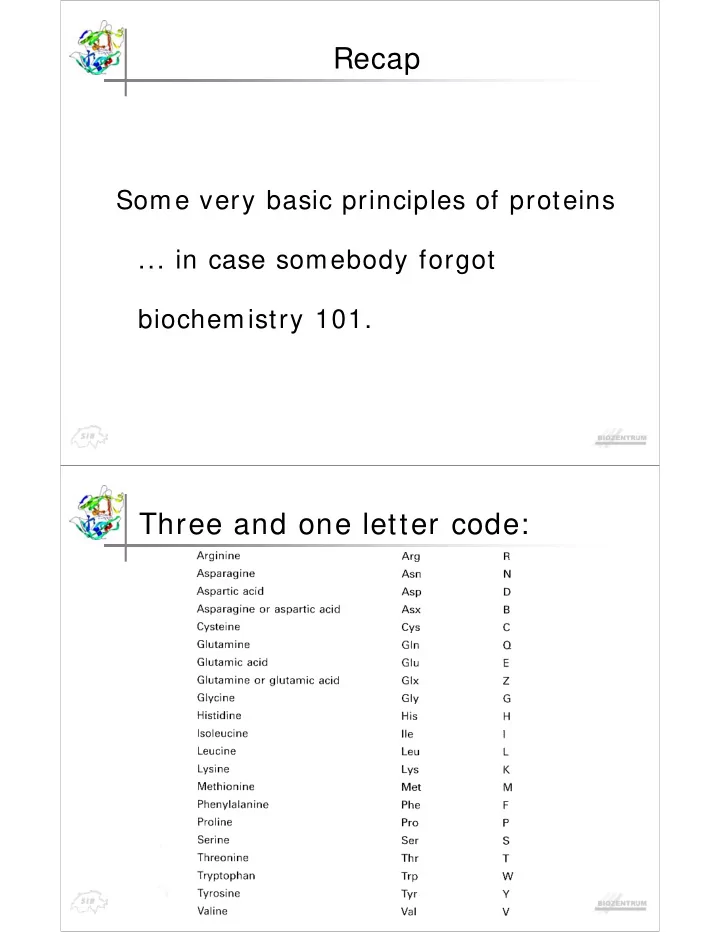

Recap Some very basic principles of proteins ... in case somebody forgot biochemistry 101. Three and one letter code:
http: / / courses.cm.utexas.edu/ jrobertus/ ch339k/ overheads-1/ ch5-amino-acids.jpg Introduction
pH and pKa [ ] � pH = − + pH log H � Water ion product [ ][ ] + − − = = 14 10 K w H OH [ ] [ ] + − − + = 14 log H log OH log 10 + = pH pOH 14 pH and pKa � Dissociation of weak acids + − ↔ + HA H A [ ][ ] [ ] + − [ ] H A HA = + = [ ] K H K [ ] − a a HA A [ ] [ ] HA + = + [ ] log H log K log − a A [ ] − [ ] A − + = − + log log log H K [ ] a HA � Henderson - Hasselbach Equation [ ] − A = + pH pK log [ ] a HA
pH and pKa Glycine 14 12 pK 2 10 8 pH 6 Isoelectric point 4 pK 1 2 zwitterion 0 0 0.5 1 1.5 2 +1 - added Equivalents of OH -1 + NH 3 NH 3 + NH 2 COOH COO - COO - pH and pKa � Glu
pH and pKa � Lys pH and pKa � Q1: Which amino-acid(s) carry a charge under physiological conditions? � Q2: Enzymatic reactions often require proton transfer. Which amino-acid(s) are able to change their protonation state under physiological conditions?
Anfinson’s paradigm � 1957, Nobel Prize 1972 Levinthal's Paradox (1968) If a chain of a hundred amino acids is considered and it assumed each amino acid can exist in one of three conformations, extended, helical or loop, then there are 3 100 possible ways to arrange this chain. This is roughly 10 48 conformations. Bond rotation can be estimated to occur at a rate of roughly 10 14 s -1 . This means that search for the right conformation through random searching alone would take the order of 10 34 s or 10 26 years, several orders of magnitudes greater than the age of the universe! � [ J. Chim. Phys. , 1968 , 85 , 44]
MNIFEMLRID EGLRLKIYKD TEGYYTIGIG HLLTKSPSLN AAKSELDKAI GRNCNGVITK DEAEKLFNQD VDAAVRGILR NAKLKPVYDS LDAVRRCALI NMVFQMGETG VAGFTNSLRM LQQKRWDEAA VNLAKSRWYN QTPNRAKRVI TTFRTGTWDA YKNL � Many proteins fold spontaneously to their native structure � Protein folding is relatively fast (nsec – sec) � Chaperones speed up folding, but do not alter the structure The protein sequence contains all information needed to create a correctly folded protein. Hydrophobic Effects � main driving force for protein folding Water molecules in bulk water are mobile and can form H-bonds in all directions. Hydrophobic surfaces don’t form H-bonds. The surrounding water molecules have to orient and become more ordered. The entropy loss can be minimized by gathering the hydrophobic surfaces together in the core of a protein and separating them from the solvent.
Energetics of protein folding Energetics of protein folding H-bonds hydrophobic effects salt bridges SS - bonds Δ G = Δ H - T Δ S loss of solvation entropy change dispersion / VdW contacts conformational energy � Difference of two very large energetic terms � Low overall stabilization energy Why do proteins fold? � Change of energy state from unfolded to folded � Folded state must have overall lower energy � Let’s assume the folded state is the lowest possible state for this polypeptide
Geometry of a peptide bond H R H R Dihedral angles Φ , Ψ , and ω Q: Which values would you you expect for ω ? ω
Dihedral angles Φ and Ψ Dihedral angles Φ and Ψ Φ = 0°, Ψ = 0°
Ramachandran Plots Ψ (deg) Φ (deg) Amino acid preferences � Alanine and Arginine ARG ALA
Amino acid preferences � Amino acid with special preferences: PRO GLY Alpha helices
Beta strands / beta sheets Visualization of protein structures
Recommend
More recommend